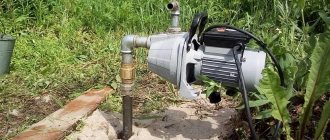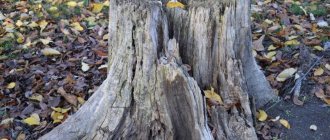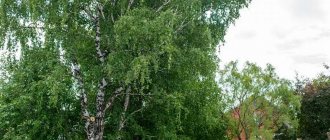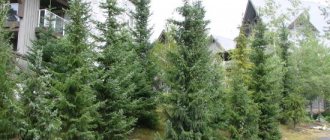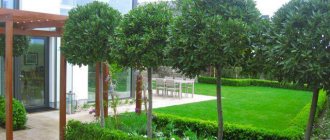It happens that when planning a site it is not possible to “go around” a tree standing in the way. True, sometimes it is even possible to fit it into a space, for example, terraces or gazebos, but more often than not, trees growing out of place, and especially old withered trees, have to be removed. It’s not difficult to cut down a trunk, but how can you get rid of a stump?
Removing a stump with a crushing machine
If the site has not yet been fully developed and there are no flower beds and lawns on it, the easiest way is to bring earth-moving equipment there and solve the problem without any effort on your part. When we are talking about an already landscaped area, it is better to invite professional uprooters, who use a powerful compact cutter that crushes the stump to a depth of 20–30 cm from the surface of the earth. This operation means local intervention in the landscape and does not cause damage to the surrounding lawn. Depending on the remoteness of the object and the complexity of the work, this service will cost from 50 rubles. per 1 cm of stump diameter. Of course, you can do the same thing yourself, but a crushing machine is an expensive tool, and there is no point in purchasing it for one-time use, although some companies have the opportunity to rent it.
Another option, the simplest and cheapest, but far from the best, is to cut the stump with a chainsaw flush with the soil. However, this patch of land will remain useless for any development - you cannot make a garden bed here, the remaining butt will interfere with the construction of garden buildings, laying paths, etc. So this approach will not solve the problem. However, chop up a piece of wood with an ax, cover it with earth, and someday (it must be said, very soon) it will turn into dust by itself.
To completely remove a stump on your own, without resorting to special equipment, you can use the following methods: manual uprooting, destruction by fire, water and chemical exposure.
Stumps that have a picturesque appearance and do not interfere with the planning of the site can serve decorative and even practical purposes. For example, by hollowing out the core, you can create a miniature flower bed in them, plant a bush plant or even a tree seedling here. And by “infecting” a stump with spores of oyster mushrooms or honey mushrooms, you can turn it into a substrate for myceliums
Manual uprooting
An excavator will effortlessly and quickly destroy a stump from a cut tree. But it is sometimes impossible to drive large equipment onto a site. A reasonable solution would be to contact a specialized arborist company that has a stump crusher in its arsenal, for example, SpilKursk.PRO But not every organization has such equipment in every region, so you have to look for a method to get rid of the stump yourself.
Uprooting stumps by hand takes quite a lot of time and requires preparation, which involves clearing the soil. This can be done by digging around the stump and its roots. Then remove the soil, throwing it aside. All that remains is to pull out the remains of the tree. There are several options on how to do this:
- Mechanically - saw off or chop off all lateral roots. What will remain is the central root, to separate which the stump needs to be turned and tilted in different directions so that it is well loosened.
- Use a winch - tie a rope around the trunk and roots, or thread it through specially drilled holes, and then gradually pull the woody remains out of the ground.
Cutting down a stump and uprooting it yourself is quite profitable, since such an approach does not require serious funding. During the day, using the manual method, they successfully get rid of several stumps on the site. But manual uprooting also has disadvantages, which are due to the laboriousness of the process, the need for additional assistants, difficulties with digging a tree trunk hole, and the remains of roots that interfere with construction. Although they remain with all methods, requiring additional uprooting.
Use of chemicals
For a long time, special chemistry has helped us in growing plants, but it can also help with their removal , if the time has come. Initially, we will look at some of the advantages and disadvantages of using chemical reagents for such a process, and then we will find out how it happens.
Advantages of the method
- A fairly inexpensive method that may not even require the involvement of professionals. It all depends on the scope of work and the chemicals used;
- The work is carried out without any damage to the surrounding landscape elements and plants, which is very good. Naturally, if you overdo it with chemistry, it can cause some harm, but we think this is unlikely to happen;
- With the help of chemicals, you can remove not only the above-ground part of the stump, but also its entirety, so you will not be disturbed by the roots under the paths on the site, as well as young growth trying to come back to life.
Disadvantages of the method
- The length of the process is one of the most important disadvantages. In fact, it can take up to three years before the stump is destroyed and the owners of the site completely forget about it;
- Using chemicals, not only plant residues are burned, but also the soil in a given place, which for a certain period of time becomes generally unsuitable for growing any vegetation.
What to use to remove stumps?
There are many chemical elements and compounds that differ in price, quality, and impact on the environment and humans. You should approach the issue very correctly and take into account absolutely all the nuances in order to remove only the old stump from the site, and not damage the skin and mucous membranes and completely kill the soil for several years.
Before using any chemical, make sure it is safe for humans, and also make sure that it will not irreversibly damage the fertility of the soil.
Chemical stump removers
- Sodium nitrate or potassium nitrate . The method using these chemicals is very simple and does not require much time. Initially, you need to add more saltpeter into the stump itself, for example, into a hollow or specially made holes. Next year, the stump must be burned out, precisely set on fire and wait until the stump burns out due to a chemical reaction and fire. This is a fairly profitable and effective method, since even the underground part burns out. But, you need to follow some rules when using saltpeter. Firstly, in order for the wood to be well saturated with the chemical, it must be poured into a large number of holes, and even in a wet form. Next, the stump is well wrapped so that rains and winter snows do not wash away the substance. The process itself is carried out at the end of summer or even in winter. The next year, the stump is set on fire and burns out, but the most important thing is that the process can only be carried out if the soil is not peat, since they quite easily catch fire from such actions, and it is not easy to extinguish them;
- Ammonium nitrate, urea . This chemical is used in almost the same way as saltpeter in the previous method, with only one difference, which greatly simplifies everything - you don’t have to set fire to the stump next year and don’t have to worry about fires. Saltpeter affects the acceleration of the decomposition of wood and, after holes are made in the stump and wet saltpeter is placed in them, it can be wrapped or even buried with earth, and after a couple of years, anything you want can be planted in this place, since the rest of the tree itself will disappear by itself.
Stump crushing
The crushing method involves the use of a special unit - a stump crusher. The essence of the method is that the stump is crushed into chips along with part of the root system to a depth of 50 cm . The stump crusher is small in size, so it can easily enter the site through the garden gate.
See what the process of removing a stump using a stump crusher looks like:
The method has many advantages:
- after crushing, only a pile of sawdust remains in place of the stump;
- crushing does not take much time - the average stump takes about 30 minutes;
- after destroying the stump in this way, you can immediately plant plants in the vacant space;
- The method is suitable even for large stumps more than a meter in diameter.
Among the disadvantages is the low crushing depth. In the vacant space, they plant a lawn or equip a garden bed, even laying a garden path. But to build a foundation or lay communication systems, you will need to get rid of the root system completely, which is also typical for other uprooting methods.
Companies involved in stump removal, in the vast majority, do not use any other removal methods other than manual uprooting and crushing, because... only these two methods can guarantee complete and rapid destruction of the stump.
Goncharov Ivan Arborist. Technical specialist at SpilKursk.PRO
Are you from Kursk region?
Employees of the SpilKursk.PRO company will help you remove the stump without a trace!
More details
Basic Tools
For manual uprooting, the following tools are required :
- shovels and bayonet shovels;
- axe;
- wood saw or chainsaw;
- scrap;
- pick;
- pin;
- sledgehammer;
- winch or hoist;
- wide nylon belt;
- steel rope.
These tools will be needed for any type of manual uprooting, so it is advisable to start work on the site by purchasing them.
Most tools are available at your local hardware or hardware store, and the pin can be made from steel reinforcement with a diameter of 15–25 mm .
To do this, you will need a piece of reinforcement 1–1.5 m long (the softer the soil, the longer the pin should be), one end of which is sharpened with a grinder at an angle of 20–45 degrees, and on the other a round heel made of sheet steel with a thickness of 10 and a diameter of 50 is welded. mm.
Burning out with fire
A free method to get rid of a stump is burning. It is focused on the use of open fire. But simply burning the woody remains is not enough; you will also have to remove the root system, since it will interfere in the future. The burning method helps remove the old stump without uprooting. But you need to approach getting rid of a stump by fire wisely.
- Drill several deep holes in the hemp.
- Pour kerosene, gasoline or charcoal lighter and other flammable liquid inside.
- Set fire to woody remains.
- If the stump is old, then the wood has already dried out, so it will quickly catch fire and burn out to the roots.
With this method, it is important to follow fire safety precautions so that the fire from the stump does not spread to the country buildings and cause a fire. To be on the safe side, it is worth pouring an earthen rampart around the hole to prevent the fire from spreading across the ground. The entire combustion process must be monitored, since a stump when smoldering can strongly shoot long-lasting sparks, which can become a source of fire. For safety, you need to prepare a fire extinguisher in advance and keep a hose connected to the water supply nearby.
This method is well suited for small old stumps (up to 50 cm in girth and up to half a meter in height). Removing a large fresh stump using fire will be problematic and expensive: you will have to light the fire more than once, and the cost of spilled fuel may be equal to the cost of removal using crushing. The method also involves constant monitoring of the combustion process.
“I look at you like in a mirror”
Types of root systems
If you know what type of tree the stump remains from, then you can easily imagine the type of its root system that you will have to deal with when uprooting. There are three of these types: fibrous,
growing in a bunch, spherical,
rod-shaped
- with a powerful median root, cone-shaped, and
superficial.
When removing a whole tree, everything is even simpler: the rhizome is like a mirror image of the crown, practically repeating its size and shape.
Types of root systems of some tree and shrub plants
| fibrous | Rod | Superficial |
| Birch | Hawthorn | Japanese crimson |
| Red maple | Elm | Amur velvet |
| Chestnut | Pear | Derain |
| Linden | English oak | Red oak |
| Larch | Rowan | Spruce |
| Loch | Pine | Willow |
| Alder | Ash | Irga |
| Fir | Silver maple | |
| Apple tree | Poplar | |
| Thuja | ||
| Bird cherry |
Mushroom method
Another option for how to remove a stump peacefully is to spread mycelium on it. It's easy to do:
- Drill several holes on the top and side of the stump.
- It is good to shed them with water and sow the mushroom mycelium. Honey mushrooms and oyster mushrooms are best suited.
- Suitable planting material can be purchased in specialized stores, or you can make it yourself from freshly picked mushrooms. To do this, the caps are crushed and filled with water, then they are stirred well and the solution is poured into the holes made.
- The best time for sowing mycelium is May-August.
- It is better to wrap the stump with moss and branches and moisten it periodically.
- Within a few months, mushrooms will sprout on the stump.
Season after season, the mycelium will draw moisture from the stump, loosening the wood. The average stump produces a tolerable harvest of mushrooms for 6 years , and then turns into dust. Then the residues can be easily removed without the use of special equipment or chemicals.
Destruction with saltpeter
One of the universal methods for removing stumps chemically is the use of saltpeter. The essence of the technique is as follows:
- In the remains of the cut tree, you need to drill many 30-centimeter holes of the maximum possible diameter.
- Saltpeter is poured into the holes and filled well with warm water.
- To speed up the process, it is better to cover the stump with plastic wrap.
- If you carry out the procedure in the spring, then by the onset of autumn the saltpeter will completely saturate the stump and have time to decompose.
- If the stump of a fruit tree is up to 15 cm in diameter, then 1 kg of saltpeter is enough to fill it. If it is thicker and the wood is harder, then the amount of saltpeter must be increased.
- When the chemical completely saturates the wood, the stump is set on fire.
Saltpeter burns well, which makes it possible to destroy even deep-growing roots without effort. But the method also has a significant disadvantage. For several years, only flower crops can be planted on the site, since the soil will not be suitable for vegetable crops. Therefore, this method is used when it is necessary to free up land for real estate construction.
Burning
Allows you to destroy a stump on a house or summer cottage without much effort. You will need a hammer drill or screwdriver, long thick drills, cotton fabric (50 cm), kerosene, diesel fuel (100-200 ml).
Procedure:
- the wood in the center is drilled from top to bottom along the entire length of the drill, then at an angle - the passages inside should intersect (for convenience, draw lines on the surface passing through the center);
- a rope is twisted from the fabric, lowered into the central passage, fuel is poured in (it is better not to use gasoline - it burns out quickly), and set on fire;
- while the wood is burning, make a few more side passages to supply oxygen;
- combustion is maintained by adding fuel and pumping in oxygen.
After about 4 hours, the base will begin to burn out, and after 12 hours only a depression will remain in the ground. The method is suitable for destroying stumps from apple trees, birch trees, and other trees, but it cannot be used near buildings, power lines, or on lands with peat layers.
Salt against stumps
Another interesting option for destroying stumps on the site is etching with salt. Table salt is a reagent that destroys wood debris. For the procedure you need:
- Drill deeper holes in the hemp on all sides.
- Fill them with table salt.
- Pour water and cover with film for a couple of years.
- After the stump turns into dust, it can be removed manually without much difficulty.
A significant drawback of the technique is that after using salt, the soil will become unsuitable for growing crops, be it flowers or vegetables. For gardening, you will have to wait a couple of years until the reagent is washed out of the soil.
When is the best time to treat?
If we are talking about preventing the spread of wood disease or wood rot, then salt, vitriol and other chemicals or folk remedies are added at any time of the year. This will help prevent infection of other plants on the site.
If there is no particular urgency, then it is best to introduce medications and folk remedies at the end of the warm period. That is, late autumn. To be more precise, a few weeks before the first frost. This is exactly the time that is enough for the reagents to penetrate below the soil level and saturate the wood even during severe frosts throughout the cold period of the year.
Decomposition by urea
One of the oldest methods of getting rid of stumps is urea. This method is the most effective and harmless; the substance is used to protect against pests and fertilize, and therefore will not cause any harm to plant crops. The reagent is absorbed into wood species and destroys them from the inside. How to remove a tree stump with saltpeter:
- Drill more holes in the stump.
- Pour urea into the holes formed and fill with water.
- Cover the stump for effective and more intensive decomposition with polyethylene.
Urea is not so harmful in comparison with other methods. After it there are no salts and nitrates left to pollute the soil. Decomposition begins quite quickly and after a year or two all the remains will rot, and fertile soil will remain in the cleared area. The method has one drawback - slow decomposition, which can take 2-3 years .
How to properly remove the roots of a bush or cut tree in an area without uprooting
Shrubs and some trees are famous for their developed root systems. Their roots can send out shoots up to 10 meters away. This makes it difficult to remove them without uprooting them.
Next, I’ll briefly talk about methods of working with the roots of “complex” plants:
- The plum constantly produces new shoots. And the provocateur is digging up the soil around. As soon as a root is carelessly cut off with a shovel, new branches immediately begin to grow from it. When destroying a stump, all root shoots are cut off with pruning shears and covered with clay or garden pitch.
- Most cherry varieties produce uncontrolled root shoots. Cutting is carried out when the shoot grows 20 cm from the ground. Over time, such a shoot dies off.
- The roots of shrubs such as lilac, sea buckthorn, and serviceberry are removed using herbicides.
Roots from bushes can also be removed using this method. Cut the plant to ground level, seal the cut and cover with soil. If you carry out the manipulations in the fall, then in the spring you can already get a clean area.
Iron or copper sulfate
These reagents are aggressive and are used as intended to disinfect roots. They kill any bacteria. Chemicals are introduced into drilled holes 5-10 cm deep and 5-8 mm in diameter. Reagents should not be used near metal pipes due to increased corrosion of the metal. The concentration of vitriol in a 3-5 meter radius around the stump is so high that nothing will grow here, and if it does, it will be extremely bad.
If the roots are uprooted after the stump has decomposed, then after a couple of years the increased amount of these substances will be reduced to the optimal level and the soil will return to normal. If the roots are burned, the soil will remain unsuitable for planting for more than 10 years .
Security measures
When using any substances, you must always remember safety precautions:
- saltpeter of any origin is a very flammable and explosive substance, which must be remembered when setting fire to a treated stump;
- You can’t even smoke near the stump in the first three months after laying the reagents, as they emit flammable gases;
- vitriol in dry form is safe for people, but you must work with it only with gloves;
- When burning stumps, you need to keep a fire extinguisher and a garden watering container filled with water on hand so that, if necessary, you can quickly extinguish the spreading flame.
It is not recommended to use reagents based on glyphosate (Santi, Typhoon, etc.), which themselves do not disintegrate in the soil, but end up in plants and their fruits, which is dangerous for people.
Save article
Author
Goncharov Ivan
Arborist. Forest feller of the sixth category. Technical specialist in the organization SpilKursk.PRO, which provides services for the care of green spaces.
Safety precautions when working with chemicals
When you decide to deal with unnecessary wood debris using chemical methods, do not forget to follow the basic rules and take all precautions.
- Firstly, be sure to use personal protective equipment when working. Choose clothing that covers all parts of your body, and wear gloves.
- Secondly, in and around the treated area, do not grow berries, plants, fruits or vegetables that will be eaten.
- Thirdly, remember that when burning hemp with saltpeter, plants planted within a meter radius of the treated area may also die. Therefore, it is better to replant crops that need to be preserved in advance.

